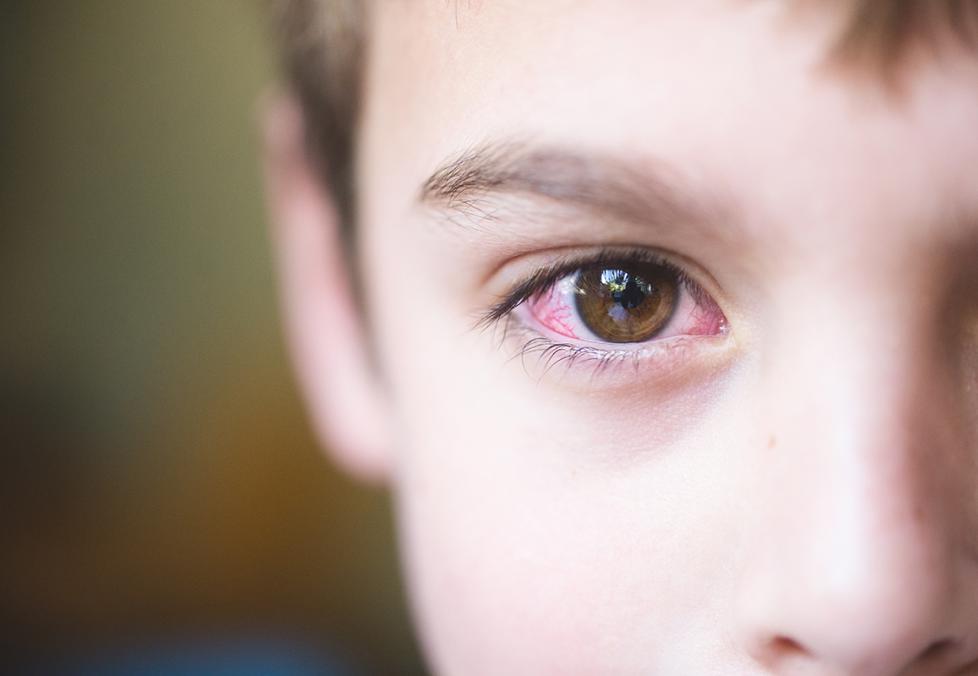
Both of these health hassles are caused by a virus — and they can happen at the same time. Here’s what you need to know to feel better faster.

Medically reviewed by Kenton McWilliams, O.D.
If you’ve ever ended up with pink eye while you’re fighting a cold, it’s not just a coincidence.
The viruses that cause colds and flu can make you more likely to catch this often-painful eye condition too. This overlap can deliver an unwelcome one-two punch that affects your clear vision while you’re also suffering from sneezing and the sniffles.
Pink eye — also known as conjunctivitis— is an eye condition that happens when the clear membrane that lines the eyelid and eyeball becomes inflamed. So, why might you catch it when you’re already sick?
“If you’re fighting a virus like a cold or flu, it could weaken your immune system,” says Kenton McWilliams, O.D. an optometrist with America’s Best in the St. Louis area. “That will make you more prone to pink eye.”
Here’s what you should know about colds and pink eye and what you can do to stop the spread and feel and see better as soon as possible.
Have questions about your eye health or vision? Your America’s Best optometrist is here to help. Find an exam time that fits your schedule.
What Pink Eye and Colds Have in Common
The majority of pink eye cases — about 75% — are the result of the same viral infections that lead to colds and flu, according to the Centers for Disease Control and Prevention (CDC). (The other two types are bacterial and allergic; learn more about them here.)
This type of pink eye typically causes watery discharge. It may start in one eye and spread to the other.
Dr. McWilliams says that the biggest giveaway of pink eye is that the eye doesn’t look normal.
“There could also be redness around the white part of the eye, as well as lots of tearing, itching, and general discomfort,” he says.
These five tips will put you on the path to recovery — while keeping others safe and in the clear.
1. Take Your Temperature and Pay Attention to Your Eyes When You Have a Cold
Your eyes may be irritated when you have a cold — even if it isn’t pink eye. Having a cold or flu can dry out the mucous membranes in your eyes and make them feel tired.
“Having a fever usually means you’re fighting a virus, so you’re more prone to eye infections if exposed,” says Dr. McWilliams.
If you do develop pink eye while fighting off a cold, know that both of these illnesses can be spread easily. “The biggest thing about coughing and sneezing is that the virus gets airborne quickly and is more likely to contaminate someone nearby,” Dr. McWilliams says.
If you wear contact lenses, stop wearing them until your eyes have cleared up or your eye doctor lets you know it’s all right to use them again.
2. Perfect Your Personal Hygiene
If you have a cold or the flu, take extra care to keep your hands clean. Most important, do your best to avoid rubbing your eyes. While it may be easier said than done, keeping your hands away from your eyes can help you avoid developing pink eye if you don’t already have it.
“You should always wash your hands regularly [for at least 20 seconds] even if you don’t think you touched anything contaminated,” says Dr. McWilliams.
If you don’t have access to soap and water, use hand sanitizer. Be extra sure you don’t touch your eyes in that case, since the sanitizer can make your already irritated eyes sting even more.

3. Try At-Home Remedies
You don’t always need to see a health care professional to treat pink eye symptoms — just like you don’t typically see a doc when you have a cold either.
There are two simple remedies that can make you more comfortable and shorten the duration of your symptoms, according to the American Optometric Association:
Cold compresses. To ease itching and swelling, soak a clean towel in cool water. Next, wring it out and apply it gently to your closed eyelids. (If only one eye is infected, take care to keep the compress away from the other eye, to avoid spreading pink eye to the clear eye.) You can use cool compresses a few times a day until the infection clears.
Over-the-counter artificial tears. Moisturizing eye drops can help relieve dryness and discomfort on the spot. Be sure to choose lubricating artificial tears — not redness- reducing drops, which could irritate your already sore eyes. If only one eye is infected, do not use the same eye drop bottle for both eyes. And get a new bottle after you’re healed.
4. Protect Others Around You
Help others in your household stay healthy by giving everyone their own linens to use. If possible, wash all pillowcases, washcloths, and towels in hot water with detergent each day. That will help kill the virus, so others won’t catch it.
Also do your best to keep all surfaces in your home clean and disinfected. “Most viruses don’t live long on surfaces, but they can be transmitted by touching a contaminated surface,” says Dr. McWilliams.
Once your infection has healed, it’s smart to replace your contact lens case and makeup brushes that you may have used while the pink eye was active. At the very least, be sure to give them a thorough cleaning.
5. Seek Medical Care If Your Condition Worsens
Newborns who have symptoms of pink eye should see a doctor right away, per the CDC. Everyone else should see a health care provider if their symptoms get worse and they also have any of these other symptoms:
- Blurred vision that does not improve when discharge is wiped from the eye(s)
- Intense redness in one or both eyes
- Pain in either or both eyes
- Sensitivity to light
- Weakened immune system from HIV infection, cancer treatment or other medical conditions or treatments
See our sources:
Conjunctivitis (pink eye): American Optometric Association
What is conjunctivitis? Association for Professionals in Infection Control and Epidemiology
Conjunctivitis (pink eye): Centers for Disease Control and Prevention

